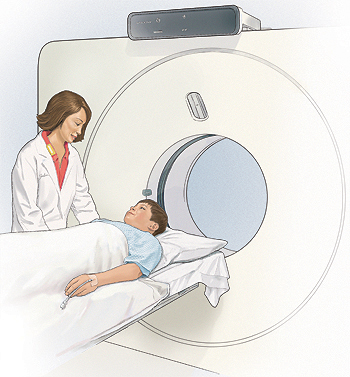CT (Computed Tomography) Scan
What is a CT scan (computed tomography)?
In conventional X-rays, a beam of energy is aimed at the body part being studied. A plate behind the body part captures the variations of the energy beam after it passes through skin, bone, muscle, and other tissue. While much information can be obtained from a regular X-ray, specific detail about internal organs and other structures is not available.
With computed tomography scan (also called CT or CAT scan), the X-ray beam moves in a circle around the body. This allows for many different views of the same organ or structure, and provides much greater detail. The X-ray information is sent to a computer which interprets the X-ray data and displays it in two-dimensional form on a monitor.
CT scans may be done with or without contrast. "Contrast" refers to a substance taken by mouth or injected into an intravenous (IV) line that causes the particular organ or tissue being studied to be seen more clearly.
What is the preparation for a CT scan?
If your child's doctor schedules a CT scan of the heart or chest and decides to use contrast dye, your child may need to be NPO (fasting, nothing by mouth) for four hours prior to the procedure. You will receive instructions about this from your child's doctor or another health care professional.
You will need to let your child's doctor know if your child has ever had a reaction to any contrast dye, or if he or she is allergic to iodine. The risk of a serious allergic reaction to contrast materials containing iodine is rare, and radiology departments are equipped to handle them. A reported seafood allergy is not considered to be a contraindication for iodinated contrast. If your teenage daughter is pregnant or could be pregnant, you should notify the doctor prior to the procedure.
Children may receive a mild sedative before the procedure to make them feel more comfortable, and to help them to remain still and quiet during the procedure, which may last 5 to 10 minutes.
Parents may be able to stay with their child in the CT scan room until he or she becomes sleepy, but are usually asked to wait in another area during the procedure to avoid exposure to unnecessary radiation.
How is the CT scan performed?
The CT scanner is located in a large room. Your child lies on a narrow table that slides into a doughnut-shaped hole that’s part of the CT scanner.

Your child may have an intravenous (IV) line for contrast medication. The contrast medication may be injected prior to the procedure or during the procedure.
The CT technologist will be in an adjacent room where the equipment controls are located. However, they will be able to see your child through a large window and will be monitoring him or her constantly during the procedure. If your child is not sedated, he or she will be given a call bell device to let the staff know if he or she needs anything during the procedure. Speakers are located inside the scanner so that your child can hear instructions from the CT staff and they can hear your child respond.
Once the procedure begins, your child will need to remain very still at all times so that movement will not adversely affect the quality of the images. At intervals, he or she will be instructed to hold his or her breath, if possible, for a few seconds. He or she will then be told when to breathe. Your child should not have to hold his or her breath for longer than a few seconds, so this should not be uncomfortable. Young children who cannot hold still for the procedure will be given medication to help them relax or sleep during the CT scan.
If the CT scan is being done "with and without contrast," your child will receive contrast medication through an IV about halfway through the procedure. He or she may feel warm or flushed just after the dye goes into the vein. This is a normal feeling and it will go away shortly.
Once the procedure is finished, the table will slide out of the scanner. If your child received medication for relaxation or sleep, he or she will be monitored until the medication wears off and he or she is awake again. If an IV was inserted, it will be taken out after the procedure is over and your child is awake.
You may be asked to wait for a short time while the radiologist reviews the scans to make sure they are clear and complete. If the scans are not sufficient to obtain adequate information, additional scanning may be done.
The test normally takes approximately 5 to 10 minutes, but you should plan on spending 30-60 minutes at the testing facility.
What happens after the procedure?
Without sedation, your child should be able to resume normal activities immediately, unless your child's doctor instructs you otherwise.
With sedation, your child may feel groggy, tired, or sleepy for a period of several hours after the procedure. However, the sedation effects should disappear within a day or so.
Depending on the results of the CT scan, additional tests or procedures may be scheduled to gather further diagnostic information.
Connect with us:
Download our App: